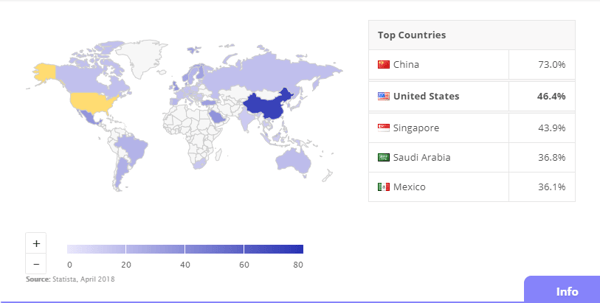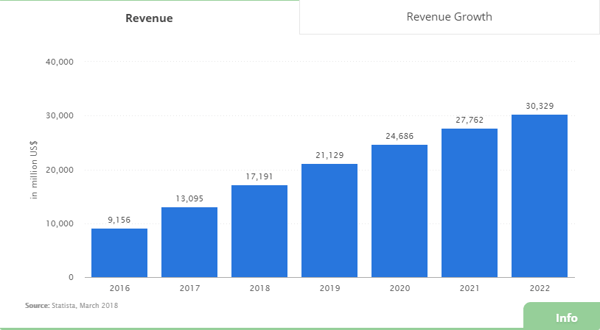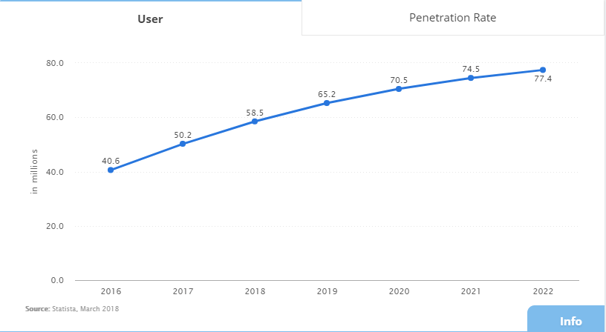
On-demand ride-sharing, wherein apps and digital services are used to organize a taxi or vehicle sharing is marking the growth of the connected mobility sector. By 2020, around 685 million people are predicted to use ridesharing services, worldwide (Statista).
Car sharing, bike sharing, shuttle, carpool are some of the services that are enabling the on-demand ride-sharing sector to thrive. The idea of more people using one vehicle not only help to curb the cost of traveling (fuel costs, tolls, maintenance charges) but also reduces the stress of driving.
Moreover, ride-sharing is a sustainable way to travel. Sharing journeys reduces air pollution, carbon emissions, traffic congestion, and also manages the need for parking spaces. For all these positive impacts, even govt’ authorities encourage the concept of ride-sharing.
Statistics that favor the rise of on-demand ridesharing

Global Comparison - User Penetration in percent in 2018

Revenue in the Ride Sharing segment amounts to US$17,191m in 2018

Number of ridesharing users in the U.S.
What’s triggering the growth of shared mobility?
Booming online service marketplace, new employment models, significant workplace flexibility are making the on-demand economy grow. For instant ride-sharing services, there has been a drastic shift in customer mindset over the acceptance of ride-sharing models. These three factors are contributing to making dynamic carpooling a success:
1. Customer Preferences: U.S. ridesharing adoption has increased from 38% in 2016 to 53% in 2017, according to SharesPost’s second annual ridesharing consumer survey. The enhanced market penetration is accounted for certain demographics, including millenials, city dwellers, and individuals who don't own a car.
2. Technology: The future of ridesharing depends on technology. Mobile apps, GPS navigation devices, constant network connectivity, e-transactions for payment are enabling seamless matching of riders and drivers in real-time.
3. Regulation: One of the biggest challenges of ride-sharing services is travelling with strangers. However, with mobile apps that are backed with technological services like GPS devices, tracking the driver, his vehicle details, and thelocation is possible, which makes ride sharing a convenient and secure experience for users.
On-demand ride sharing: Existent, successful models
Ride-sharing is a tried-and-tested model. Over the years, a number of startups have evolved as an established on-demand transportation service providers. They not just introduced innovative models to hail, share, and ride vehicles, but also proved it as a successful business model. Some of them are:
- Uber is the big shot in app-based ride-sharing services. Operating in more than 200 cities across the globe, Uber allows people to book pre-screened drivers for carpool.
- Ola is an India-based ride-hailing and sharing service that allow its its users to book or share a ride with an app.
- BlaBlaCar is a long-distance carpooling platform that connects drivers with vacant seats with passengers to share travel cost.
For ride-sharing, there are two types of vehicles involved that picks up people from defined location. Services like Uber, Lyft uses commercial vehicles for sharing rides. On the other hand, BlaBlacars, MatchRider are ridesharing models that allow daily commuters to use their private vehicle for sharing rides. While the concept works similar, the type of vehicle differs.
Have an idea to transform the ride-sharing industry?
Hundreds of ideas click innovative minds, daily. But, how they will be persevered by the targeted persona is a big question that startups need to have an answer for.
We, at Daffodil, believe that validating an idea is important. Considering the cost, tech resources, and time that goes into the implementation of an idea, we have our Discover and Frame workshop for startups. It creates a roadmap for the product idea that helps in estimating its success rate.
If you too have an idea that you think can disrupt the on-demand industry for ridesharing, share it with us to know best development practices.



